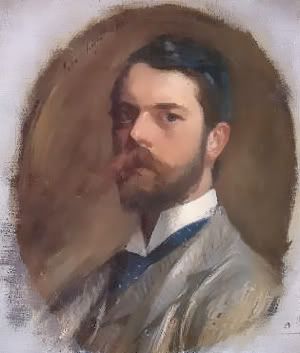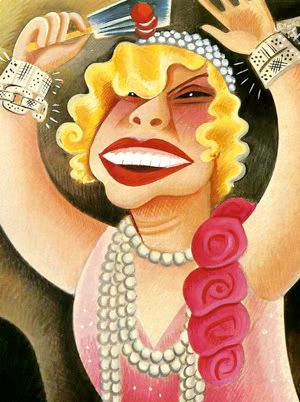Wednesday, January 12, 2011
All In The Family: "Meet The Bunkers"
On this day in 1971 a show which was definitely not your parents' sitcom made its debut on CBS. Only to say that All in the Family 'made its debut' is like saying a hurricane or an earthquake made its debut; what it did accomplish was nothing short of a revolution, sweeping aside its anodyne predecessors like the dust in which it left them...
Not only did Meet The Bunkers introduce a more honest generation gap than had ever been seen on television before into American living rooms, it promoted dialogue on taboos on a scale and to a degree which had never even been attempted, and have rarely been handled so elegantly since. It was and is a show conservatives and liberals alike could and can watch, laugh at - even think it's on their side, and not be wrong in either case. The series' overall message seemed to be: isn't it better to laugh at our differences than come to blows over them? At a time in which young people and the authorities were clashing in the streets - sometimes fatally - a show like this, which could so effectively clear the air on the vital issues of the day, seemed less like a sitcom and more like a public service...
Initially, however, producer Norman Lear had to talk Carroll O'Connor into doing it; a lifelong liberal, O'Connor worried about what his portrayal of arch-conservative Archie Bunker would do to his reputation. So while he initially accepted the role to mock the kind of character Archie was, over time O'Connor came to understand the kind of fear and lack of critical thinking which goes into making any bigot; over the course of the series he even helped bring the character to a kind of rapprochement with the rapidly changing world in which he found himself stranded.
Ably aided here by Jean Stapleton as Edith Bunker, Rob Reiner as Mike Stivic, Sally Struthers as Gloria, and Mike Evans as Lionel Jefferson, they and the rest of the cast would eventually guide their massive audience through eight perilous years of the 1970s without either repressing or denying the volatility of the times, but rather by embracing it. Now, thanks to the magic of DVD, you too can embrace All in the Family all over again...
*
Pop History Moment: "All In The Family" Debuts
On this day in 1971 the first episode of All in the Family - entitled Meet The Bunkers - introduced the world to five characters - Archie Bunker, Edith Bunker, Mike Stivic, Gloria Bunker-Stivic, and Lionel Jefferson - who in their way would encourage greater dialogue about social issues in America than ten times as many do-gooders and do-badders (also known as politicians) could ever dream of doing. No issue was too sacred for them - many even too taboo at that point for most living rooms - and the touchiest issue of them all (even to this day) race was discussed more than any other.
For the next eight seasons (including five consecutive years as the number one show in the country) the sitcom antics emanating from that drab lower-middle-class home in Astoria electrified viewers as Archie (played to the hilt by Carroll O'Connor) struggled to cope with a changing world and his own role in it as both a white male and paterfamilias.
By no means, though, were the uber-liberal Mike (Rob Reiner) and Gloria (Sally Struthers) always right, which is what made the show as great as it was (and still is); the show's break out character, however, was Edith. As portrayed by Jean Stapleton Edith was, in the words of series producer Norman Lear, a kind of Christ figure - long-suffering, wise and compassionate.
All in the Family was itself based on a British sitcom called Til Death Us Do Part, created by Johnny Speight and aired on the CBS television network. It spawned the equally popular spin-offs Maude and The Jeffersons, the less popular shows Gloria and 704 Hauser and inspired Hanna-Barbera's animated series Wait Till Your Father Gets Home; so popular was the show that even its spin-offs had spin-offs. Good Times spun off of Maude, and Checking In spun off of The Jeffersons.
*
In Memoriam: John Singer Sargent
Proof of John Singer Sargent's genius is not in the pudding, but rather in the impasto; any further proof one might require should come from the envy of his success shown by his contemporaries and the critical drubbing his work received while he was alive. Indeed, the work which was Sargent's favourite and which is today considered his finest work - 1884's Portrait of Madame X - was widely panned when it was first shown. There's a lesson in there somewhere for today's cultural workers of all kinds, but I can't quite put my finger on it...
 Sargent's career was prolific, resulting in more than 900 paintings, 2000 watercolours, and numerous drawings; he is renowned for his portraits - whether socialites, writers, or politicians - but he created landscapes as well. Later in life he also took up sculpture.
Sargent's career was prolific, resulting in more than 900 paintings, 2000 watercolours, and numerous drawings; he is renowned for his portraits - whether socialites, writers, or politicians - but he created landscapes as well. Later in life he also took up sculpture.
Born on this day in 1856, Sargent was fortunate enough to train in the progressive atelier of Emile Auguste Carolus-Duran; Sargent's mentor favoured the alla prima method of painting which freed painters from a hidebound methodology that had been in use ever since the Renaissance, and would give rise to Impressionism.
Although born in Italy to American parents, Sargent spent most of his professional life in England; when one of his better known patrons, Edward VII, recommended him for a knighthood, though, he declined the offer.
Since most of his work was generated for commission, successive generations of artists have not venerated Sargent or his work anything like his considerable skills would suggest; English art critic Roger Fry, of the Bloomsbury Group, sniffed at Sargent's work in 1926, saying it lacked aesthetic quality. Then, as now, the successful, popular artist (whose acclaim, in this case, protected a scandalous private life from public approbation) is seen as worse than useless, while the wretch in the garret is the only 'real' artist.
Yet surely an essential component of aesthetics is the desire of people to look at the work, and today - more than eighty years after his death - ordinary people are still looking at the work of John Singer Sargent, despite what the pretentious might perceive as its shortcomings.
*
Born on this day in 1856, Sargent was fortunate enough to train in the progressive atelier of Emile Auguste Carolus-Duran; Sargent's mentor favoured the alla prima method of painting which freed painters from a hidebound methodology that had been in use ever since the Renaissance, and would give rise to Impressionism.
Although born in Italy to American parents, Sargent spent most of his professional life in England; when one of his better known patrons, Edward VII, recommended him for a knighthood, though, he declined the offer.
Since most of his work was generated for commission, successive generations of artists have not venerated Sargent or his work anything like his considerable skills would suggest; English art critic Roger Fry, of the Bloomsbury Group, sniffed at Sargent's work in 1926, saying it lacked aesthetic quality. Then, as now, the successful, popular artist (whose acclaim, in this case, protected a scandalous private life from public approbation) is seen as worse than useless, while the wretch in the garret is the only 'real' artist.
Yet surely an essential component of aesthetics is the desire of people to look at the work, and today - more than eighty years after his death - ordinary people are still looking at the work of John Singer Sargent, despite what the pretentious might perceive as its shortcomings.
*
"Mama, He Treats Your Daughter Mean" by Ruth Brown
Once the most popular female R&B singer in the world, Ruth Brown led a famous battle against Atlantic Records and lost, following which her once-glittering career went into a sharp decline; rediscovered in the 1970s, her comeback included more than concerts, but TV and movies as well. In 1979 she appeared in the short-lived (and much-mocked) sitcom Hello, Larry, and in 1986 she portrayed Motormouth Maybelle in John Waters' classic movie Hairspray.
Although she died in November 2006, today would have been her eighty-second birthday; here we see her in an early performance, assaying one of her classics, Mama, He Treats Your Daughter Mean.
*
Remembering... Texas Guinan
Already famous in vaudeville and silent films as America's first movie cowgirl - nicknamed 'Queen of the West' - shortly after Prohibition was introduced Texas Guinan opened a speakeasy called the 300 Club at 151 W. 54th St. in Manhattan...
 Her clarion call - 'Hello suckers!' - greeted young and old, famous and obscure alike, and they not only loved it, they loved her for it. Her patrons didn't come for the caustic greeting or stay for the over-priced turpentine passing for hooch but to rub elbows with the cream of society and to rub far naughtier things with the parade of scantily-clad dancers she employed; Ruby Keeler and George Raft were just two of the future stars who found fame (and Heaven knows what else) while working for her...
Her clarion call - 'Hello suckers!' - greeted young and old, famous and obscure alike, and they not only loved it, they loved her for it. Her patrons didn't come for the caustic greeting or stay for the over-priced turpentine passing for hooch but to rub elbows with the cream of society and to rub far naughtier things with the parade of scantily-clad dancers she employed; Ruby Keeler and George Raft were just two of the future stars who found fame (and Heaven knows what else) while working for her...
Riding high on her newfound notoriety as a proprietress, Guinan returned to the movies. Queen of the Night Clubs (1929) and Broadway Through a Keyhole (1933) both saw her playing thinly veiled versions of herself; equally thinly veiled portrayals of her have been assayed by Mae West in the George Raft movie Night After Night (1932) and Gladys George in The Roaring Twenties (1939). She's also been portrayed on film by Betty Hutton in Incendiary Blonde (1945) and in Splendor in the Grass (1961) by Phyllis Diller. Sadly, a rumoured musical of her life starring Madonna seems unlikely to surface...
Born on this day in 1884, Texas Guinan's life 'closed out of town' - to use the showbiz parlance - while on tour in Vancouver; it's there she contracted amoebic dysentery and died in November 1933, one month before the repeal of Prohibition.
*
Riding high on her newfound notoriety as a proprietress, Guinan returned to the movies. Queen of the Night Clubs (1929) and Broadway Through a Keyhole (1933) both saw her playing thinly veiled versions of herself; equally thinly veiled portrayals of her have been assayed by Mae West in the George Raft movie Night After Night (1932) and Gladys George in The Roaring Twenties (1939). She's also been portrayed on film by Betty Hutton in Incendiary Blonde (1945) and in Splendor in the Grass (1961) by Phyllis Diller. Sadly, a rumoured musical of her life starring Madonna seems unlikely to surface...
Born on this day in 1884, Texas Guinan's life 'closed out of town' - to use the showbiz parlance - while on tour in Vancouver; it's there she contracted amoebic dysentery and died in November 1933, one month before the repeal of Prohibition.
*